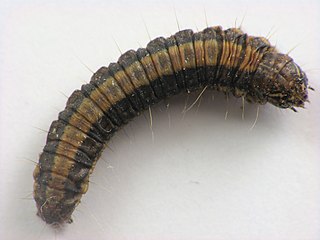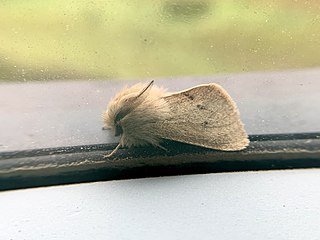
Sphinx franckii, or Franck's sphinx moth is a moth in the family Sphingidae. The species was first described by Berthold Neumoegen in 1893. It is known from lowland deciduous woodland in the eastern United States but also suburban areas where lilacs are planted, ranging from New York to northern Florida east to Missouri and Louisiana.
Doidae is a family of Lepidoptera first described by Julian P. Donahue and John W. Brown in 1987. It is sometimes treated as a subfamily of the Notodontidae. Species have been placed in the Arctiidae, Lymantriidae and the Dioptidae.

Neoarctia is a genus of tiger moths in the family Erebidae. The genus was erected by Berthold Neumoegen and Harrison Gray Dyar Jr. in 1893.
Pygarctia is a genus of moths in the family Erebidae.

Spilosoma is a genus of moths in the family Erebidae originally described by John Curtis in 1825. A very heterogeneous group, it is in need of review by the scientific community, as certain species probably need reclassification into their own genera.
Aon noctuiformis, the aon moth, is the only species in the monotypic moth genus Aon in the family Erebidae. The species is known from the US state of Texas. Both the genus and the species were first described by Neumoegen in 1892.
Eupseudomorpha is a monotypic moth genus of the family Noctuidae erected by Harrison Gray Dyar Jr. in 1893. Its only species, Eupseudomorpha brillians, was first described by Neumoegen in 1880. It is found in the southwestern part of the US state of Texas.
Edwardsimemna is a monotypic moth genus in the family Lasiocampidae erected by Berthold Neumoegen and Harrison Gray Dyar Jr. in 1894. Its single species, Edwardsimemna jalapae, described by Henry Edwards in 1884, is found in Mexico.
Hypopacha is a monotypic moth genus in the family Lasiocampidae. The genus was erected by Berthold Neumoegen and Harrison Gray Dyar Jr. in 1893. Its only species, Hypopacha grisea, described by Neumoegen in 1882, is found in the US states of California and Arizona.

The Epipaschiinae are a subfamily of snout moths. Almost 600 species are known today, which are found mainly in the tropics and subtropics. Some occur in temperate regions, but the subfamily is apparently completely absent from Europe, at least as native species. A few Epipaschiinae are crop pests that may occasionally become economically significant.
Gazoryctra roseicaput is a moth of the family Hepialidae. It was described by Berthold Neumoegen and Harrison Gray Dyar Jr. in 1893. It is known from the mountains of western North America, including Washington, Oregon, British Columbia and Alberta.
Arachnis citra is a moth of the family Erebidae. It was described by Berthold Neumögen and Harrison Gray Dyar Jr. in 1893. It is found in North America, including Arizona, California, Colorado and Utah.

Pygarctia roseicapitis, the red-headed pygarctia moth, is a moth in the family Erebidae. It was described by Berthold Neumoegen and Harrison Gray Dyar Jr. in 1893. It is found in Mexico and in the United States from southern Arizona to Texas.

Spilosoma pteridis, the brown tiger moth, is a moth in the family Erebidae. It was described by Henry Edwards in 1875. It is found in the United States in western Oregon and Washington, British Columbia and northern Idaho. The habitat consists of wet forests west of the Cascades, including coastal rainforests, low elevation mixed hardwood-conifer forests, as well as higher elevation conifer forests in the Cascades.

Spilosoma vagans, the wandering diacrisia or wandering tiger moth, is a moth in the family Erebidae. It was described by Jean Baptiste Boisduval in 1852. It is found in western North America, from southern California, southern Utah and central Colorado north to southern British Columbia and south-western Alberta. The habitat consists of drier forests, including open ponderosa pine forests and mixed hardwood-conifer forests.
Givira is a genus of moths in the family Cossidae.
Dalcerides is a genus of moths of the family Dalceridae. It was described by Berthold Neumoegen and Harrison Gray Dyar Jr. in 1893.

John Bernhardt Smith was an American professor of entomology who specialized in systematics and economic entomology while also serving as the State Entomologist of New Jersey. Smith is remembered in insect taxonomy for the conflict that he had with Harrison Dyar.

Berthold Neumoegen was a German-born American stock-market investor and amateur entomologist who specialized in the Lepidoptera.








